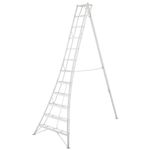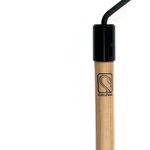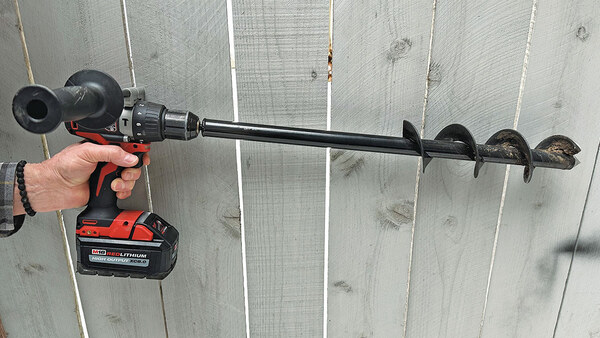
The biggest disruption to a garden’s peace and serenity typically is the exhaust-laden cacophony of power equipment. Happily, today’s new battery-powered outdoor power equipment offers a quieter, more convenient, more environmentally friendly way to get the same chores done.
For generations, gasoline has been the old standby for running lawn and garden machines. There are also corded electric outdoor tools, but doing yard work tethered to an extension cord has always been an annoying compromise. So it’s no surprise that there’s a better option in this age when there is a cordless power tool for practically any task. I can say with certainty that we’re in the middle of the “real deal” era for battery-powered outdoor power equipment, and the list of capable tools in the category is growing like a weed.
Electric motors are efficient
There are some performance benefits specific to the DC electric motors used in battery-powered tools. Compared to gas-powered motors, they can produce high torque at low rpms and can often do the same job with higher efficiency at moderate motor speeds. There’s no need to rev up to high rpms to generate power, as you do with gas engines. Since the tools are electric, they can beep or flash various alerts to the user, while onboard sensors can shut down a tool if its motor or battery pack begins to overheat. Some tools even have LED headlights built in— whether they are necessary or not.
As part of the contemporary array of power tools developed over the last decade or more, battery-powered outdoor tools use lithium-ion (Li-ion) chemistry instead of the nickel-cadmium (NiCad) or nickel–metal hydride (NiMH) formulations of days past. Li-ion technology represents a huge leap forward and is one of the main reasons cordless tools have evolved into the bigger and stronger products available now. These tools are capable of rivaling the performance of many corded electric tools developed for construction, woodworking, or lawn and garden uses.
Another huge leap forward is the use of brushless motors in cordless tools. Besides their greater efficiency and power per size, the computer chip that controls the motor’s operation can be programmed for other advanced control features, such as safely drawing the most current out of a specific-size battery pack. Tools with brushless motors usually represent the premium tier from a given brand, but because of the performance level needed for outdoor work, most brands of battery-powered outdoor equipment feature all-brushless motors now.
What tools are available?
Most brands start with four basic handheld tools that have the highest demand by users: string trimmers, hedge trimmers, blowers, and chain saws. To get to the “big five,” they add a lawn mower. That’s all most households need, but companies hoping to attract professional users may offer dozens of models.
Besides chain saws with different bar lengths and various models of string trimmers and mowers, additional tools include pole saws, extended-reach hedge trimmers, edgers, and power brooms. For “stick” tools such as string trimmers and pole saws, some brands offer power heads that let you use one motor to power a variety of attachments. Other commercial-style tools include top-handle arborist chain saws, backpack blowers, and even snowblowers and riding mowers. Because of their much higher power needs, riding mowers don’t use the battery packs common to the rest of a manufacturer’s outdoor tool line.
Some companies offer tools with smaller battery packs, such as one-handed grass shears, compact hedge trimmers, or miniature pruning chain saws with a 4-inch bar. And there are now battery-powered, roaming robotic mowers that return to their charging shelter when they need a fill-up or when programmed to do so. These tools offer a fascinating glimpse into the future of semi-autonomous maintenance robots, but I doubt they could handle my bumpy yard.
Whether you are new to the world of battery-powered tools or want to add to your collection, you will surely be impressed with the capability of tools that are now available.
Battery power is cleaner and greenerHandheld tools powered by battery packs offer several advantages over those that burn fossil fuels. There’s no need to buy, transport, or store gasoline. If you’re used to two-stroke tools, you will be happy to say goodbye to the routine of properly mixing in oil, then trying to use up the fuel before it goes bad within several weeks—or buying premixed fuel that costs about $30 a gallon. Battery-powered tools offer low- to no-maintenance operation. They do not require yearly maintenance or engine tune-ups, and you won’t need to winterize them at the end of the gardening season. There’s no idle screw to fiddle with, and no high and low carburetor-adjustment screws. The tools are quieter and often safer. There is no toxic exhaust to breathe, no screaming engine noise within arm’s length, and no hot muffler to burn yourself on. Many of these tools are quiet enough to be used without hearing protection. Battery-powered tools offer point-and-shoot simplicity. Push the ON button if the tool has one, then simply pull the trigger to operate. You won’t have to set a choke, pull a cord to start the engine, wait out a flooded carburetor, or restart the engine after every time you set the tool down. These tools run only when you pull the trigger, with no noisy, fuel-wasting idling time. As an added benefit, most handheld cutting tools have an active brake that stops the tool instantly when the trigger is released, so you don’t have to wait for the tool to coast down. A tool that is silent between tasks makes it much easier and safer for the user to communicate with others. What are the cons? All you really give up is the all-day run time of a gas engine and the extra power needed for commercial-sized tools such as large chain saws, which still require high-performance two-stroke engines. Other than that, battery-powered outdoor equipment is available with capabilities suitable for almost any gardening job. |
Michael Springer is a craftsman, tool tester, construction industry journalist, and tree care worker based in Boulder County, Colorado.
Fine Gardening Recommended Products

Hasegawa Tripod Ladder
Fine Gardening receives a commission for items purchased through links on this site, including Amazon Associates and other affiliate advertising programs.

CobraHead® Long Handle Weeder & Cultivator Garden Tool
Fine Gardening receives a commission for items purchased through links on this site, including Amazon Associates and other affiliate advertising programs.

























Comments
Great article really impressed . I think you should also write article about Cylindrical battery assembly . This will be beneficial for others I guess thank you.
Log in or create an account to post a comment.
Sign up Log in